Are you looking for a condiment for barbecues and sandwiches? Sweet and spicy pickles are the PERFECT summer pickle. A colorful mix of vegetables flavored with garlic and ginger. This simple fermented recipe is easy and delicious!
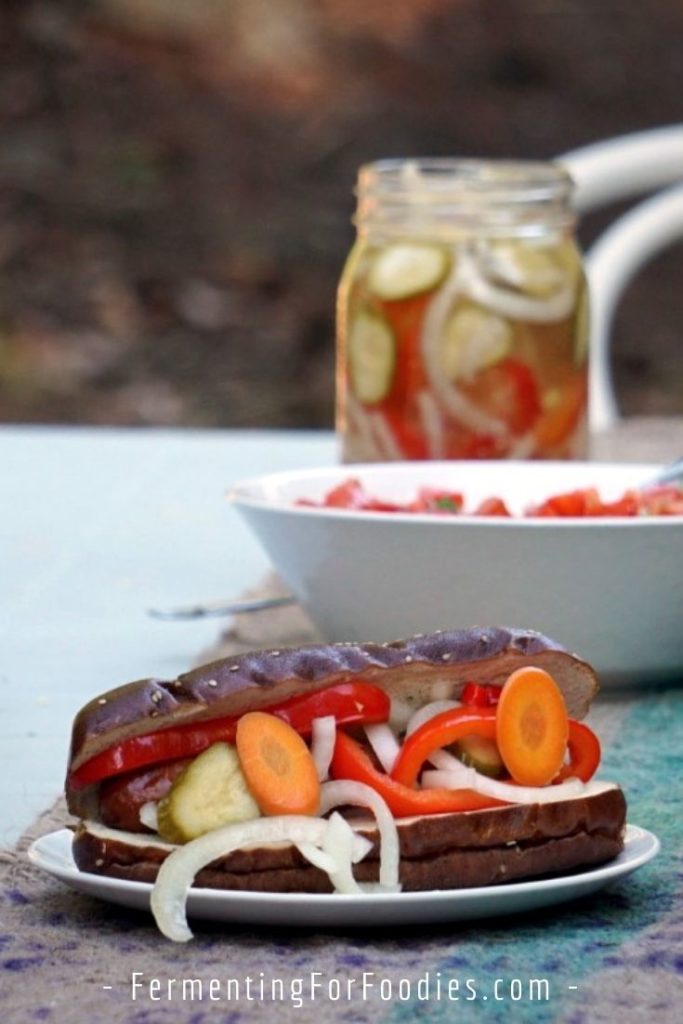
This simple no-cook and zero-waste recipe is one of my favorites. I usually make a batch as soon as barbecue season starts, then I reuse the brine for a continuous supply of pickles! See the section below for more details.
How to serve sweet and spicy pickles
While my kids will eat pickles straight from the jar, here are a few more serving suggestions.
- Perfect for barbecues: These pickles are delicious on burgers, veggie burgers, or hotdogs.
- Sandwiches: I LOVE sweet and spicy pickles in a cheese sandwich. They go perfectly with extra old cheddar.
- Charcuterie: A colorful addition to a charcuterie or appy platter.
- Salad: For a quick salad, toss a cup of pickled vegetables with lettuce.
- Toppings: I add a forkful of fermented vegetables to pretty much every meal. They’re delicious as a side dish or served on top of a soup, stew, or Buddha bowl. These sweet pickles are a probiotic alternative to sauerkraut for anyone with a sweet tooth.
Continuous Batches of pickles
The brine can be reused for several batches of pickles. When you’re almost done eating the pickles, fill a new jar with carrots, peppers, cucumber, and onion. Then pour the brine over the vegetables. The ferment will go more quickly the second time, so only ferment for 1 day, then let the pickles sit in the fridge for another 3 to 5 days for the flavors to blend.
I usually make 2-3 extra batches of pickles from the original liquid.
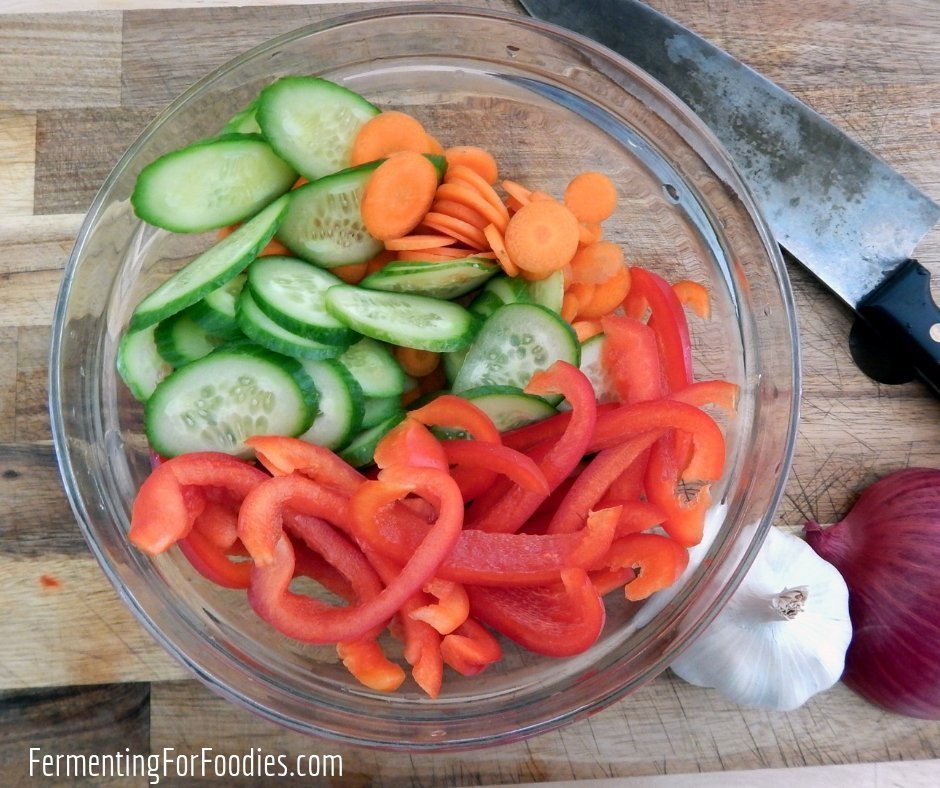
Sweet And Spicy Pickles
This pickle is a bright combination of salty, spicy, and sweet. It’s packed full of flavor from the onion, garlic, and ginger which mellows nicely with fermentation. The perfect pickle for the summer season. See the section above for serving suggestions.
- Prep Time: 20 minutes
- Total Time: 20 minutes
- Yield: 1.5 quarts 1x
- Category: Pickles
- Method: Fermented
- Cuisine: Vegan
- Diet: Gluten Free
Ingredients
For the Brine
- 1 cup of apple cider vinegar (with mother, see notes)
- 1 cup of water, chlorine-free
- 1/4 cup of sugar
- 2 tsp non-iodized salt
- 2 cloves of garlic, finely diced
- 1 Tbsp of ginger root, finely chopped
Vegetables
- 1 cup thinly sliced cucumbers (about 2 small cucumbers)
- 1 colored pepper, thinly sliced
- 1/2 red onion, thinly sliced
- 1 cup of carrots, thinly sliced in rounds (about 2 large carrots)
- 1 chili pepper, sliced in circles (optional, for those who like heat)
Instructions
- Mix the salt, sugar, water, and cider vinegar in a large measuring cup. Stir to dissolve the salt and sugar.
- Slice the vegetables and mix them in a large glass bowl.
- Pack the vegetables into a glass jar(s) for fermenting. They don’t need to be pounded in as you do for sauerkraut, just tightly packed. This recipe will fill a 1.5 quart (1.5 L) jar or two 1-quart jars.
- Divide the garlic and ginger between the jars. Then pour the brine over the vegetables. There should be enough to completely cover them.
- Use a weight (or a smaller jar) to keep the vegetables from floating, then cap with a lid and allow them to ferment somewhere cool and dark for 2-3 days. A closet or cupboard is perfect.
- Store in the fridge to curb the fermentation. The pickles will last in the fridge for at least 2 months, however, the vegetables will get softer over time, so I recommend eating them eat them within one month. See the information above on reusing the brine for continuous fermented pickles.
Notes
- These pickles use cultured apple cider vinegar for the ferment. To make sure your ACV will work, look for vinegar labeled raw, unpasteurized, or with the mother. For example, Bragg’s works well. These pickles can also be made with strong brewed kombucha or jun.
- Sugar is not required, however, the resulting pickle will be salty. Sugar also helps feed the ferment, so the pickles won’t be quite as sweet as you may expect.

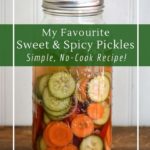
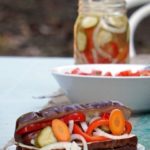
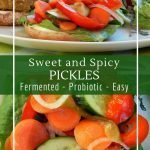
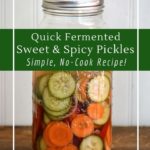
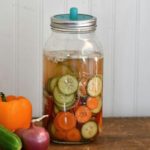
Would a tea towel be an appropriate loose covering? And okay to use a plastic bowl (I don’t have a large glass bowl, only stainless steel or plastic…)?
You could ferment in a jar, then transfer to a second jar for finishing. Glass is the least reactive… you just don’t want to have a metal or plastic flavour in your ferment. Though a hard plastic bowl or stainless steel should be fine.
Excellent! My kids especially enjoy this one.
Hello I made these pickles and they’re absolutely delicious but everybody keeps saying they’re not probiotic I let them sit on the counter for 5 days and put them in the ice Box and they are marvelous but they keep saying they’re used vinegar and it so therefore it’s not romantic could you please tell me different thank you love the recipe but need Fermentation
I’m glad you like the recipe! There are lots of types of fermentation. Salt-brined vegetables are one particular type. I have LOTS of those sorts of recipes on the site. But if they don’t suit your taste buds, then you can ferment vegetables in other ways. 🙂 This recipe depends on raw ACV for the culture. As long as you’re using ACV with a mother, it has a yeast and bacterial culture. However, I understand why people are concerned. Vinegar-preserved pickles aren’t fermented. However, adding vinegar doesn’t necessarily stop fermentation. If you’re curious, I wrote a whole post about it: https://www.fermentingforfoodies.com/does-vinegar-stop-fermentation/
Be well, Emillie
Hello again and thank you for the line and the link for probiotic foods which benefits and stuff that was absolutely excellent I’ve learned a lot and thank you for the fermentation because I love that recipe and I hate giving it to my brother so it’s true they are fermented and I did use mother vinegar that’s all I use but thank you so much for a great recipes stay well Stay well and thank you for replying
Do you know if monkey fruit would work in these pickles in place of the sugar?
Thanks!
Hi Jeanne, The sugar in this recipe is to feed the ACV and help it ferment. Unfortunately, monk fruit doesn’t have the sucrose necessary to feed the yeast in ACV. If you want a lower sugar version, try using only 2 Tbsp of sugar. Nearly all the sugar will be used up by the ACV ferment. Then you can sweeten afterwards with monk fruit.
Cheers! Emillie
Thank you, Emilie. Makes sense.
What would happen if pasteurized ACV vinegar is used in place of raw?
Hi Gayle,
This is a ACV based ferment. Using pasteurized vinegar will still result in a delicious quick-pickle, however, it won’t be fermented. The resulting pickle will be sweeter and less sour. Just pop it in the fridge like other quick refrigerator pickles instead of leaving it out to ferment.
Cheers, Emillie
Awesome! Thanks so much for sharing. I am really enjoying your website!
Thanks!